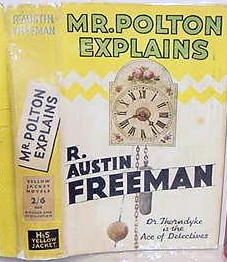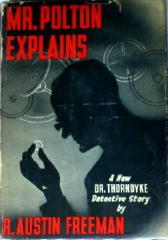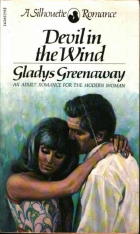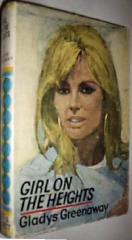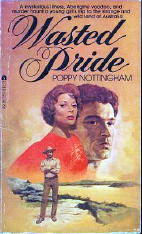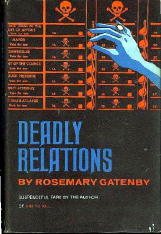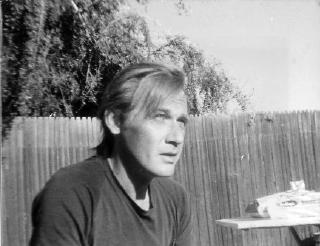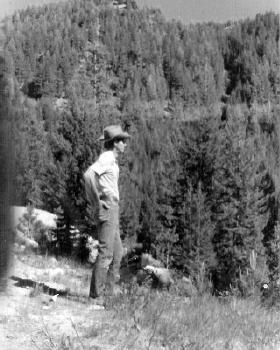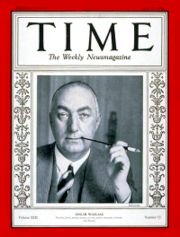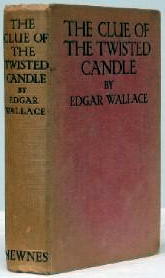March 2007
Monthly Archive
Sat 31 Mar 2007
Excerpted from his
Wikipedia entry:
“R(ichard) Austin Freeman (April 11, 1862 – September 28, 1943) was a British writer of detective stories, mostly featuring the medico-legal forensic investigator Dr Thorndyke. He invented the inverted detective story, in which the identity of the criminal is shown from the beginning: some of these were collected in The Singing Bone in 1912.
“[Using] some of his early experiences as a colonial surgeon in his novels … a large proportion of the Dr Thorndyke stories involve genuine, but often quite arcane, points of scientific knowledge, from areas such as tropical medicine, metallurgy and toxicology.”
R. AUSTIN FREEMAN – Mr Polton Explains
Hodder & Stoughton, UK, 1940. Dodd Mead, US, 1940. Popular Library #70, pb, 1946.
We’ve probably all played “what if,” going further and further back in our lives to establish the chain of circumstances which led to playing the very game itself, and in this case to your reading this review.
Mr Polton Speaks, written in two parts, begins in this fashion. Nathaniel Polton, orphaned as a toddler, relates the various stages of his somewhat Dickensian life up to his making Dr Thorndyke’s acquaintance, the circumstances of which explain his devotion to the good doctor. He also tells how he learnt certain skills, some of which will be very useful to his employer when he becomes servant/assistant to Dr Thorndyke.
Much detail is given about Mr Polton’s interest in a particular profession and a specific invention of his which, years later, provides a vital clue to unraveling a mysterious death, the circumstances of which form the second part of the book, narrated by Dr Jervis. To my surprise Mr Polton actually states which particular knowledge contributed to the solution of the crime, though this revelation was not really needed because between autobiographical comments and the description of the scene of the crime it is obvious how the murder was accomplished, if not the person responsible.
In brief, a fire completely guts a house where Mr Haire has taken rooms. Fortunately for him, he was in Ireland at the time, but unfortunately his cousin, Cecil Moxdale, was staying in the flat. The building is completely burnt out and the body is found more or less charred out of recognition although items found in the debris establish its identity.
And yet … certain aspects of the death suggest it was not accidental or even suicide and so Thorndyke and Jervis become involved. Although the resolution hinges on a whacking great coincidence which stretches the long arm of coincidence so much it’s amazing it didn’t fall off, on rereading Mr Polton’s section I found circumstances described there (in a more subtle manner than the statement mentioned above) do in fact provide a fair clue or two to the alert reader.
My verdict: Alas, this is the most disappointing of this author’s works read so far. In fact, it gives the distinct impression Mr Polton’s autobiography was grafted onto a short story to form a novel. The necessary information could, I believe, have been provided within the section penned by Dr Jervis easily enough and in a far less obvious manner. Shocking to relate, I found Mr Polton’s life story more interesting than the mystery and its resolution, though the latter did have an unexpected twist.
E-text link: http://gutenberg.net.au/ebooks05/0500371.txt
Fri 30 Mar 2007
Every one of author Gladys Greenaway’s 11 books listed in CFIV are indicated as having marginal crime content.
GREENAWAY, GLADYS (1901- )
* -Shadows in the Sand (n.) Hurst 1958
* -View of the Mountain (n.) Hurst 1959
* -Follow a Shadow (n.) Hale 1961
* -Spring Came Late (n.) Hale 1961
* -Week of Suspense (n.) Hurst 1962
* -No Looking Back (n.) Hurst 1963
* -Sing Softly, Stranger (n.) Hurst 1963
* -The Affair at Little Todsham (n.) Hurst 1964 [England]
** -Devil in the Wind (n.) Hurst 1966
* -Follow My Leader (n.) Hurst 1966
** -Feather Your Nest (n.) Hurst 1967
Those with double asterisks were reprinted in the US by Ace in paperback form, suggesting that they were published as “gothics” at a time when gothics ruled the paperback book business. Gladys Greenaway has a number of other titles to her credit, continuing on to 1982, if not longer. Presumably these are straight romances, with no criminal content to speak of.
It was John Herrington again who has confirmed her year of death as 1991. Other than her books being offered for sale on the Internet, a Google search brings up no additional information about her.
[UPDATE] 03-31-07. To demonstrate that research into the writing careers of mystery authors never ends, John Herrington has pointed out that Gladys Greenaway’s middle name and initial are “Ivy M.”
Also, while looking for copies of her books online, or other information about her, I discovered that Girl on the Heights, a title not listed above, was described by one bookseller as a “Inspector Henry Mason novel.” Even with only this one line, it was immediately obvious that this is a book that should be included.
I sent the information on to Al Hubin, and he immediately agreed. Not only that, well, read his reply:
Steve,
You’re right, and I can’t discount most of her other novels either. They may be straight romances (at least one of them is), but I guess these additions/changes should be made to her entry in the CFIV Addenda #8:
-Cousin Alison. Hurst, 1969
-Girl on a Ladder. Hurst, 1972
Girl on the Heights. Hurst, 1968
-The Late Summer of Christine Hargreave. Hurst, 1970
-My Mother’s Daughter. Hale, 1983
-No Looking Back. Correct publication date to: 1960
-The Past Is the Prelude. Hurst, 1971
-The Small Circle. Hale, 1979
-Trial Run. Hale, 1982
-View of the Mountains. (title correction)
-Where the Wind Whistles. Hurst, 1964
And I wonder about her novels as Julia Manners, but I can’t find any definite information.
The hunt for new facts and data never ends!
Fri 30 Mar 2007
It was John Herrington who came up with some data on Andrew Spiller, a prolific British author essentially unknown in the US. Not one of his books was ever published in this country. To demonstrate what I meant by “prolific,” here’s his complete bibliography, thanks to CFIV:
SPILLER, ANDREW
* If Murder Interferes with Business (n.) Archer 1945 [England]
* Rope for Breakfast (n.) Archer 1945 [England]
* Whom Nobody Owns (n.) Archer 1945 [England]
* Queue Up to Listen (n.) Archer 1946 [Det. Insp. Arthur “Duck” Mallard; England]
* Crooked Highway (n.) Archer 1947 [Det. Insp. Arthur “Duck” Mallard; England]
* What’s in a Name? (n.) Archer 1947 [Det. Insp. Arthur “Duck” Mallard; England]
* When Crook Meets Crook (n.) Archer 1947 [Det. Insp. Arthur “Duck” Mallard; England]
* And Thereby Hangs- (n.) Paul 1948 [Det. Insp. Arthur “Duck” Mallard; England]
* Murder Has Three Dimensions (n.) Archer 1948 [Det. Insp. Arthur “Duck” Mallard; England]
* You Can’t Get Away with Murder! (n.) Archer 1948 [Det. Insp. Arthur “Duck” Mallard; England]
* Brief Candle (n.) Paul 1949 [Det. Insp. Arthur “Duck” Mallard; England]
* Birds of a Feather (n.) Paul 1950 [Det. Insp. Arthur “Duck” Mallard; England]
* The Man Who Caught the 4:15 (n.) Paul 1950 [Det. Insp. Arthur “Duck” Mallard; England]
* Phantom Circus (n.) Paul 1950 [Det. Insp. Arthur “Duck” Mallard; England]
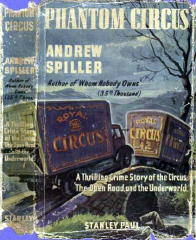
* Alias Mr. Orson (n.) Paul 1951 [Det. Insp. Arthur “Duck” Mallard; England]
* Who Plays with Sin (n.) Paul 1951 [Det. Insp. Arthur “Duck” Mallard; England]
* As They Shall Sow (n.) Paul 1952 [Det. Insp. Arthur “Duck” Mallard; England]
* Kiss the Book (n.) Paul 1952 [Det. Insp. Arthur “Duck” Mallard; England]
* The Evil That Men Do (n.) Paul 1953 [Det. Insp. Arthur “Duck” Mallard; England]
* They Tell No Tales (n.) Paul 1953 [Det. Insp. Arthur “Duck” Mallard; Ship]
* Murder Is a Shady Business (n.) Paul 1954 [Det. Insp. Arthur “Duck” Mallard; England]
* Murder Without Malice (n.) Paul 1954 [Det. Insp. Arthur “Duck” Mallard; England]
* It’s in the Bag (n.) Paul 1955 [Det. Insp. Arthur “Duck” Mallard; England]
* Ring Twice for Murder (n.) Paul 1955 [Det. Insp. Arthur “Duck” Mallard; England]
* Black Cap for Murder (n.) Paul 1956 [Det. Insp. Arthur “Duck” Mallard; England]
* Brains Trust for Murder (n.) Paul 1956 [Det. Insp. Arthur “Duck” Mallard; England]
* Curtain Call for Murder (n.) Long 1957 [Det. Insp. Arthur “Duck” Mallard; England]
* Murder on a Shoestring (n.) Long 1958 [Det. Insp. Arthur “Duck” Mallard; England]
* Sing a Song of Murder (n.) Long 1959 [Det. Insp. Arthur “Duck” Mallard; England]
* The Man Who Dressed to Kill (n.) Long 1960 [Det. Insp. Arthur “Duck” Mallard; England]
What John recently discovered is that Spiller was born in Bridport, 20 June 1891, and he died in Ealing, London 11 February 1976. Neither his year of birth or the year he died had been known before. And surprisingly enough, what you see here on this page, right now, is all that is known about the author.
[UPDATE] 04-09-07. It hasn’t taken long before some additional information about Andrew Spiller has come to light. Look for that, plus a few more cover images, in this later blog entry, posted today.
Fri 30 Mar 2007
Until a couple of weeks ago, all that was known about Poppy Nottingham, author of four gothic romantic suspense novels included in Crime Fiction IV, except her real name:
NOTTINGHAM, POPPY; pseudonym of Patti Dunaway
* Hatred’s Web (n.) Ace 1974 [Louisiana]
* Shadow of a Cat (n.) Ace 1974 [Canada]
* Without a Grave (n.) Ace 1975
* Wasted Pride (n.) Ace 1978 [Australia]
DUNAWAY, PATTI; see pseudonym Poppy Nottingham
* Surrender by the Sea (n.) Jeremy 1979
What happened a couple of weeks ago was that a woman in California purchased from me one of these gothic paperbacks written as by Poppy Nottingham, explaining that the author was the wife of her former pastor and she remembered both of them well. That was enough information to help Al Hubin locate her husband, Jack Dunaway, still alive and well in Oregon. In a letter Al received from him recently, Mr. Dunaway said his wife was born October 9, 1936 and died September 12, 1988. He also added that “she always wanted to be a writer; she wrote gothic novels because they were clean and she knew what they wanted.”
Fri 30 Mar 2007
The first syllable of Rosemary Gatenby’s last name rhymes with “late,” which means I’ve been pronouncing incorrectly to myself all this time. According to Social Security records, this author of nine suspense thrillers listed in CFIV died January 3, 2007, but her writing career ended with her final mystery in 1979, when she was still a youthful 61.
Below is a semi-annotated list of the mysteries she wrote, using CFIV as the basis. One gauge of an author’s popularity, perhaps, is how many of their books are picked up by one or the other of the book clubs which were in operation during their career. In Mrs. Gatenby’s case, this would have been either the Mystery Guild or the Detective Book Club. I’ve indicated those of her books which were published by either of the two with a double asterisk (**).
GATENBY, ROSEMARY (1918-2007)
* Evil Is As Evil Does (n.) M. S. Mill–William Morrow 1967. No paperback edition. “Betty Graham, formerly Liz Melinder, returns to Rockton, NY, to attend a round of parties for herself and her new husband. Little did people know that she had escaped the worst train wreck in history and her former life as wife and mother.”
* Aim to Kill (n.) William Morrow, 1968. Pyramid X-2094, pb, October 1969.
** Deadly Relations (n.) William Morrow, 1970. Pyramid T2528, pb, 1971.
** Hanged for a Sheep (n.) Dodd Mead, 1973. Jove 04418, pb, 1977. “Taut dramatic story of a successful, solidly married man who is unable to convince the law and even his friends of his innocence [in his wife’s murder].”
** The Season of Danger (n.) Dodd Mead, 1974. Jove 04429, pb, 1977. “How could America’s most famous novelist be held a prisoner by his own guards on his own estate?”
** The Fugitive Affair (n.) Dodd Mead, 1976. Jove 04428, pb,1978.
* The Nightmare Chrysalis (n.) Dodd Mead, 1977. Jove 04805, pb, 1979. “Even before the half nude body of the strangled girl was found in the woods in back of his house, Ferguson Brady’s live had begun to change.”
* Whisper of Evil (n.) Dodd Mead, 1978. Berkley 04673, pb, March 1982. “The young red-haired woman on the plane to Mexico City did not know that someone urgently wanted her death … that it had already been discussed …”
** The Third Identity (n.) Dodd Mead, 1979. No paperback edition.
Fri 30 Mar 2007
Among the various pieces of data that Al Hubin is always on the lookout for, in terms of adding and correcting information in Crime Fiction IV, his all-inclusive bibliography of the field, are the death dates of authors who have passed away, but for whom this information has never been recorded, for whatever reason.
This does not include the giants of the field, of course. It’s almost always the lesser known writers, those who were popular at one time but whose career in the area of mystery fiction faded away after their death; or those who wrote only a handful of books to begin with, perhaps more for the love of the field rather than for the money, and so never had a following at all.
Most of these authors were active and their careers ending before the Internet came along. With a few exceptions, most of today’s authors have their own web pages or have been interviewed often enough online or in the print media that we know as much about them as we could possibly want to know.
What I’m grouping together this evening are some of the authors whose deaths have been recently discovered. There is no other factor that they have in common than that. Truthfully, each of these deserves a blog entry of their own, and if I ever accumulate enough interesting facts about any one of them, that is exactly what will I will do.
[UPDATE] 07-01-07. And that is exactly what I have done. Each of the authors in this original post now has his or her own entries, dated the same day as this first one. Follow the links to find each of the author’s new entries:
Thu 29 Mar 2007
About a month or so ago I posted a
review of
Travis, an all-but-unknown private eye novel by M. E. Knerr. In the review I included all I was able to find out about the author, who also wrote a few crime-related novels as Michael E. Knerr.
After the review was posted, I continued trying to find out more about Knerr, eventually coming across several Internet postings about him by John F. Carr. Carr is a science fiction writer and editor with a long list of credits on the Internet Speculative Fiction Data Base.
Carr’s recent endeavors have largely been in conjunction with the SF (and occasional mystery) writer, H. Beam Piper, keeping his work in print and writing several stories and novels in Piper’s “Lord Kalvan” series. He recently finished a biography, H. Beam Piper: A Biography for McFarland & Company, which will be published next year. There’s a connection between Piper and Knerr, which Carr addresses in his reply to me, after I was able to get in touch with him:
You came to the right person, as I knew Michael – not very well, but better than probably any other writer left alive. Michael’s middle initial was E., and while I’m not familiar with Travis, according to his son, it’s Mike’s book. He wrote a number of books for Monarch and Pinnacle in the late 50’s and early 60’s. In 1962 he went to Southern California, where he wrote a number of soft-core porn books for various outfits, like Uptown Books – all pretty harmless in today’s vernacular! I have a copy of The Sex Life of the Gods, and it’s pretty typical hackwork… Better than some, but not up to the stuff Sturgeon and Farmer were doing a few years later.
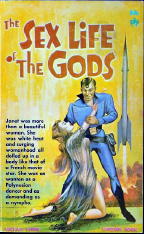
Mike was in many way Beam’s protege, and his closest friend during his last few years in Williamsport, Pennsylvania before Piper shot himself on November 9, 1964. They met at a local Williamsport writers’ group in 1959 and they spent a lot of time together talking about writing and drinking. Mike was absolutely devastated by Beam’s suicide. In fact, he blamed himself for not realizing that Beam needed help. The truth was that Mike was married, with two young sons and working full time as a reporter, and had neglected, for these very good reasons, his friend Beam Piper.
I’m sure Piper understood, and his problems were far deeper than any small loan would have addressed. Piper was a very private man and would have never burdened a friend with his personal or financial problems. He took what he thought was the only sensible way out of what he saw was a closed box — a stalled career, the recent death of his friend and long-time agent Kenneth White, a bad case of writer’s block and no money. He was too proud and self-sufficient to ever go on relief!
I first heard about Mike Knerr through the offices of Ace Books and my then editor Beth Meacham, when Mike called her, extremely irate over my factual errors about his “best friend, H. Beam Piper” in my introduction to the Piper short story collection, Federation. I told Beth to have Mike call me direct and we had a good conversation; I told him that I was only writing what other people had told me that Piper had said about his ex-wife and other factual errors. After Mike calmed down, he admitted that Piper “told a lot of bullshit about his past” and we ended the conversation on a good note. We corresponded and he provided me some information on Beam’s life and quotes from his diaries, which he had in his possession.
After our talk Mike discovered the “lost” Fuzzy novel (Fuzzies and Other People) in one of the trunks that he’d taken from Piper’s apartment mislabeled in a box as “second pages.” In lieu of payment (Ace Books offered him several thousand dollars — Mike called it “blood money”) for the “lost” Fuzzy book — Mike stuck a deal whereby he would write a biography of Beam based on his first-hand knowledge and Piper’s diaries which ran from 1955 to his death. Ace agreed and he sat down and over the next several years wrote the book Piper. Unfortunately, when he turned the book in Ace reneged and told him they were no longer interested. He was about to destroy it when I called to obtain his permission to quote his letters for the article, “The Last Cavalier: H. Beam Piper,” I was writing for Analog Science Fiction–Fact magazine.
Mike was mad as hell, and I managed to calm him down a bit and told him it would be a crime if he destroyed Beam’s legacy in a fit of pique, since he had the only copy of the diaries. Instead, I suggested that he send me a copy of his Piper biography for safe keeping. You could have knocked me over with a paper clip when three months later it arrived in my P.O. Box! He sent me the original manuscript; I know that because it was backed with several other manuscripts (a lot of old timers did this to save on paper). I am certain that I have the only copy in existence…
I lost contact with Mike in 1992, when he was living in Sausalito with his third or fourth wife. He was a good looking guy, and a great man for the ladies. He moved around a lot, and did the typical writer’s gigs, worked at Sylvania, a local newspaper, etc.
See the attached photos. In person, he had a raspy voice and a violent demeanor, like one of his own anti-hero protagonists! He wasn’t someone you’d mess around with.
His books, like The Violent Lady (Monarch, 1963), were pretty good for the time and the outfits he wrote them for. He really wanted to write historical novels based in Central Pennsylvania, but couldn’t sell them. His agent was Kenneth White, who died in 1964, which is when Mike decided to cut back his writing to hobby status, although he would have never put it that way!
I talked to his son recently and he told me his father was born on May 31, 1936 in Williamsport, PA (where Piper was based in the early 60’s, which is my connection). He was a hunter, civil war re-enactor, horseman, built flintlock rifles, and loved boats and sailing.
Mike was a former newspaper man (the Shamokin newspaper) and in 1973 moved permanently (except for a short time in Woolrich, PA) to Southern California, specifically Alameda, Sausalito and L.A.
Here’s the list of titles his son gave me of Knerr’s works: The Violent Lady, 3 Willing Females, The Sex Lives of the Gods, Heavy Weather, Sasquach, Suicide in Guyana, Brazen Broads, Operation: Lust, and Travis. He isn’t sure if this list is complete, probably not since many were written under pseudonyms and/or were lost in his many moves…
Mike Knerr died in 1999. I don’t have the actual date, just a note from his son that he died at age 64.
This is about the sum total of my knowledge of Mike, except that I liked him even though he was a rough cob – I sure as hell wouldn’t have wanted him as an enemy!
NOTE: A chapter excerpted from The Last Cavalier, John’s biography of H. Beam Piper, has been uploaded to the original Mystery*File website. Entitled “California Dreamin’” and largely in Mike Knerr’s own words, it describes his experiences writing soft-core porn in California before returning to Pennsylvania, and the time he spent with H. Beam Piper in Williamsport before the latter took his own life.
Wed 28 Mar 2007
Posted by Steve under
Authors[11] Comments
ON ELLIOTT CHAZE
by Bill Pronzini
Elliott Chaze (1915-1990) was an old-school newspaperman who began his journalism career with the New Orleans Bureau of the Associated Press shortly before Pearl Harbor, worked for a time for AP’s Denver office after paratrooper service in WW II, and then migrated south to Mississippi where he spent twenty years as reporter and award-winning columnist and ten years as city editor with the Hattiesburg American.

In his spare time he wrote articles and short stories for The New Yorker, Redbook, Collier’s, Cosmopolitan, and other magazines, and all too infrequently, a novel. In an interview he once stated that his motivation in writing fiction, “if there is any discernible, is probably ego and fear of mathematics, with overtones of money. Primarily I have a simple desire to shine my ass — to show off a bit in print.”
His first two novels were literary mainstream. The Stainless Steel Kimono (Simon & Schuster, 1947), a post-war tale about a group of American paratroopers in Japan, was a modest bestseller and an avowed favorite of Ernest Hemingway.
The Golden Tag (Simon & Schuster, 1950), like most of his long works, has a newspaper background, contains a good deal of autobiography, and is both funny and poignant; it concerns a young wire service reporter and would-be novelist in New Orleans who becomes involved with two women, one of them married, while reporting on a sensational murder case.
His third novel was the one for which he is best remembered today, Black Wings Has My Angel (Gold Medal, 1953; also published as One for My Money, Berkley, 1962 and as One for the Money, Robert Hale, 1985).
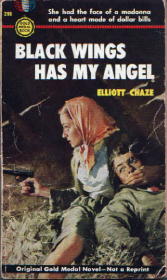
Black Wings Has My Angel is an indisputable noir classic, arguably the best of all the crime novels published by Gold Medal during its glory years. Barry Gifford, in an article in the Oxford American, called it “an astonishingly well written literary novel that just happened to be about (or roundabout) a crime.”
The protagonist, ex-convict Tim Sunblade, is a quintessential antihero — an unrepentant bastard who executes a daring armed car robbery in Colorado with the help of a call girl, Virginia, whom he picked up in a backwoods Mississippi motel.
The details of the crime and its aftermath are vividly described, and the love-hate relationship between Sunblade and the woman and the demons in both that lead to their downfall are masterpieces of dark-side character development. Unreservedly recommended.
It was ten years before Chaze published another novel, and sixteen years before his next crime novel, Wettermark (Scribners, 1969). In its own quiet, sardonic way, Wettermark is every bit as good as Black Wings Has My Angel. Its setting is the small town of Catherine, Mississippi, a thinly disguised Hattiesburg, where the protagonist, the eponymous Wettermark, toils as a newspaper reporter for the local paper.
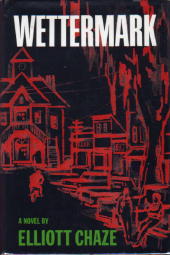
Wettermark is a tragicomic figure, accent on the tragic — a tired, financially strapped, ex-alcoholic wage slave whose novelist ambitions have long since been shattered by rejection and apathy. His arrival on the scene of a recent successful bank robbery plants a seed in his mind, a “glimpse of the green” that is nurtured by circumstance and his private demons until it blossoms into a daring heist scheme of his own.
Wettermark is by turns funny, sad, bitter, mordant, and ultimately as dark and unforgiving as Black Wings — a brilliant character study that is likewise unreservedly recommended and that somebody damned well ought to reprint.
Late in his life, after he had retired from the Hattiesburg American, Chaze wrote three offbeat, ribald (occasionally downright bawdy), and often hilarious mysteries, all published by Scribners, featuring Kiel St. James, a well-meaning but somewhat bumbling city editor for the Catherine Call (Catherine having been mysteriously moved from Mississippi to Alabama for this series); Crystal Bunt, Kiel’s highly sexed young photographer girlfriend; and Chief of Detectives Orson Boles, a tenacious cop given to wearing hideous lizard green polyester suits ( “I like green, hoss”) and speaking alternately in Southern grits-and-gravy dialect and perfect English.
Each of the three, Goodbye, Goliath (1983), Mr. Yesterday (1984) and Little David (1985), drew enthusiastic critical praise — The New Yorker called them “good, down-home fun [with] much flavorful redneck talk…plenty of excitement too” — but they seem to have been inexplicably neglected, if not all but forgotten, in the years since.
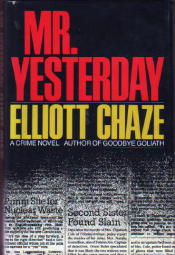
The best of the trio is Mr. Yesterday, which deals with the murders of two eccentric old spinsters, one by a fall and one by a bizarre (very bizarre) stabbing. The motive for the two killings, and the method employed in one, are the weirdest, wildest, most inventive, most audacious (and yet completely plausible) ever devised in a mystery novel.
Some readers no doubt did and will find the explanation offensive, even borderline obscene. I laughed out loud when it was revealed, which may tell you more about my sense of humor than you care to know, but I’m pretty sure the author would have approved.
Elliott Chaze was a fine prose stylist, witty, insightful, nostalgic, and irreverent, and a first-class storyteller. If you’ve never read anything of his, or nothing except Black Wings Has My Angel, by all means hunt up copies of Wettermark, Mr. Yesterday, and anything else with his byline. You won’t be disappointed.
Wed 28 Mar 2007
In
my recent review of British author Brian Flynn’s
The Sharp Quillet, I included all of the information about him that I had or was able to come up with Not included in this data was his year of death, which was suspiciously missing, given that he was born in 1885. I asked John Herrington if he might look into the matter.
I also asked him if there was any way of gauging how popular an author Flynn may have have been in the UK. Obviously, I said, he’s all but unknown here, and apparently his work seems to have faded badly in England as well. But with all of the books he had published, he must have had some readers who followed him … ?
Here’s John’s reply, cobbled together out of two emails I received from him today.
Hi Steve,
Flynn died in Deal, Kent on 5th February 1958. He must have been writing right up to the end as his last two books followed later in 1958.
Unfortunately, that is the sum of my findings. Kent record office know nothing about him. But I do have a couple of suggestions to follow up.
[As far as Brian Flynn is concerned as a writer] Barzun in Catalog of Crime, says of the one book he lists “Straight tripe and savorless. it is doubtful, on the evidence, if any of his others would be different.”
I know nothing about him and reckon he is what I would call a journeyman writer, writing prolifically to make some money. Though he must have some effect to have written 50 books, which is 49 more than lot of people. Perhaps being so prolific, and keeping the same character throughout, was his error.
He wrote for what we call library publishers, publishers whose aim was to produce books which libraries would buy – often by quantity rather than by author. If libraries bought his books, he would keep on writing. Sadly, just because libraries buy one’s books it does not necessarily mean you are a good writer. Most books, especially fiction, will find library readers because “they have read everything else on the shelves” (This is personal experience speaking, having worked for 3 decades in a public library and seen some right rubbish get elevated to “I must look out for the next one”!) I suppose some library borrowers will read anything as they don’t need to buy it.
Sadly, I get the impression that Flynn was one of the lucky ones who found his niche and carried on till he died (and two books did come out after he died).
How good was he actually? No idea. Barzun condemned him on one book, right or wrong. But I simply think he was writing for the library market and that could be a limitation as far as style and improvement would be concerned. In those 50 books there may have been a good writer struggling and failing to improve his lot.
Anyway, will let you know if I find anything else.
Tue 27 Mar 2007
From the online
Wikipedia: Richard Horatio Edgar Wallace (April 1, 1875 – February 10, 1932) was a prolific British crime writer, journalist and playwright, who wrote 175 novels, 24 plays, and countless articles in newspapers and journals. Over 160 films have been made of his novels, more than any other author. In the 1920s, one of Wallace’s publishers claimed that a quarter of all books read in England were written by him.
EDGAR WALLACE – The Clue of the Twisted Candle
George Newnes, London, hc, 1917. Small Maynard & Co.,Boston, hc, 1916. Numerous reprints in both hardcover and paperback. TV Film: An episode of The Edgar Wallace Mystery Theatre, 15 August 1960, with Bernard Lee as “Superintendent Meredith.”
Assistant Commissioner of Police T. X. Meredith, a man of unorthodox though successful methods of detection and best friend of mystery writer John Lexman, has been investigating Remington Kara, an extremely rich Greek with something of a turbulent history and a former suitor for the hand of Lexman’s wife.
Kara was almost murdered years ago, and such is his fear of another attempt being made his bedroom is “practically a safe.” It features burglar-proof walls, reinforced concrete roof and floor, an unreachable window, and its sole door has in addition to a lock “a sort of steel latch which he lets down when he retires for the night and which he opens himself personally in the morning”.
Of course Kara is eventually found dead, locked in this safe-like room. How was Kara’s murder accomplished, why did his secretary disappear and his manservant run away, and for that matter who killed the dog in the basement of his house? Was Kara killed by the men he has feared for years or someone else, and if so, who was it and why?
Answers to these conundrums are revealed at a gathering at the end of the book in which All Is Explained, including how the challenge presented by the locked room was overcome.
My verdict: On the negative side I felt there were perhaps one too many coincidences and the identity of the murderer was not as well hidden as it might have been. On the other hand, the locked room explanation is ingenious, clues to how it was accomplished are revealed in a fair fashion in the narrative, and I confess I did not foresee one of the final twists. I would sum it up as a diverting, light read.
Etext available online.
Next Page »
